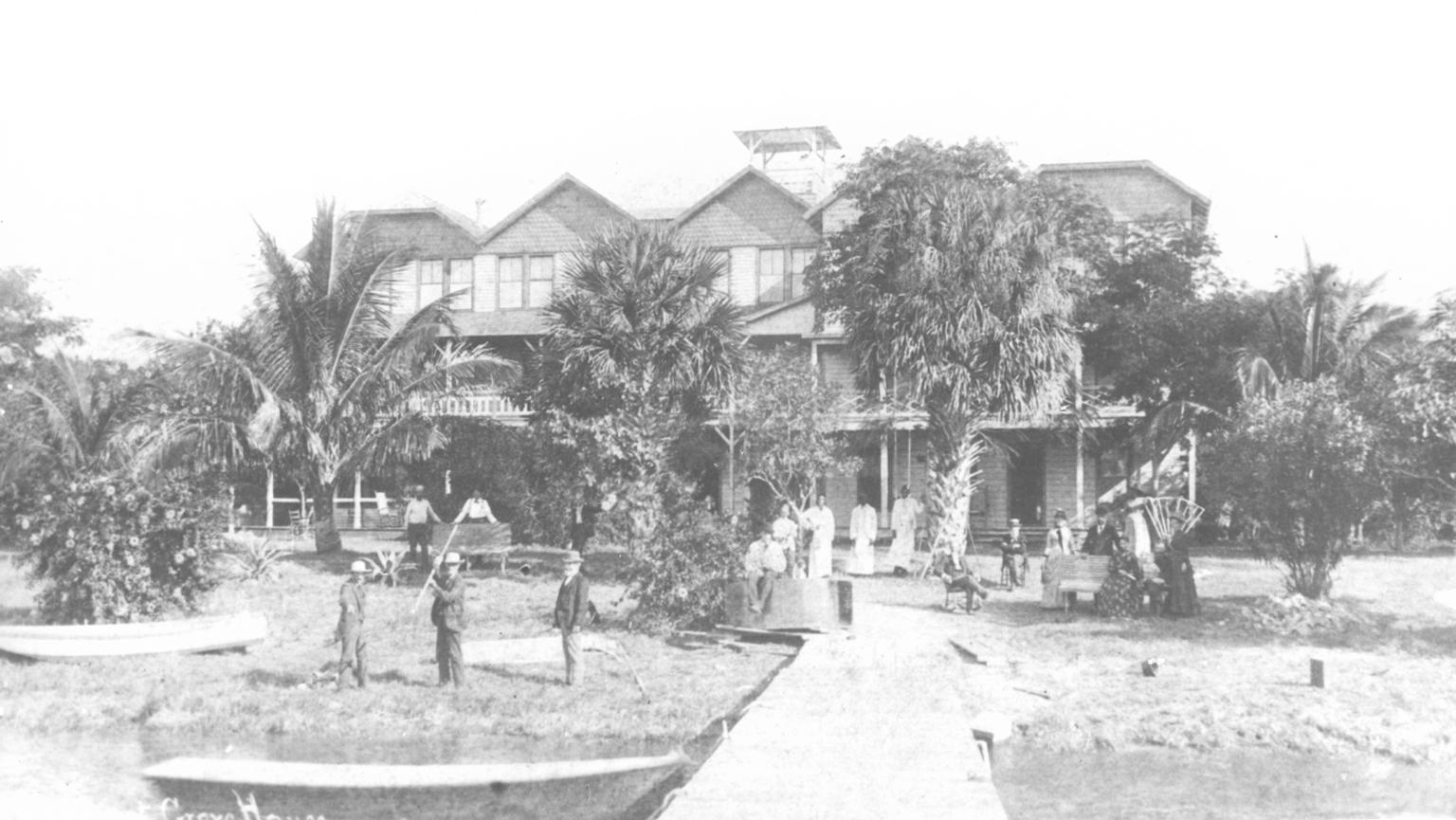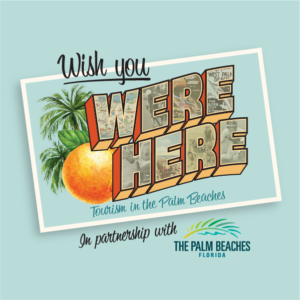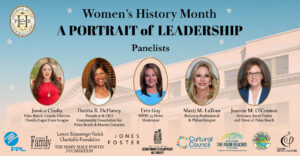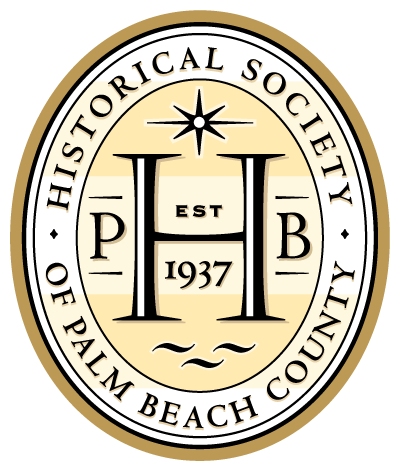
This article from the 2010 spring issue of Tustenegee was written by Richard “Tony” Marconi, former HSPBC Director of Education. For proper context, please note the original publication year of all reprinted articles here. They receive only minimal editing.
As it was over a hundred years ago, Palm Beach is a favorite destination during the winter season. Thousands of winter tourists come to enjoy the mild winter climate between October and April. When Henry M. Flagler, Standard Oil executive and Florida hotel and railroad builder, arrived in the jungle paradise that was Palm Beach in 1893, he built the grande dame of hotels, the Royal Poinciana (1894), followed by the Palm Beach Inn (now The Breakers) two years later. He extended his Florida East Coast Railroad to West Palm Beach and Palm Beach to bring the wealthy to vacation at his hotels during the winter season. With the combination of hotels for the rich and easy transportation to Palm Beach, Flagler brought tourism to new heights that have continued into the 21st century. But were there hotels and tourism here before Flagler’s arrival? The answer is yes. Before Flagler, tourism and hotels were flourishing along Lake Worth between 1880-1893.

During the Pioneer Era (1860-1893), before the area was known as Palm Beach, it was known as the settlement of Lake Worth, which should not be confused with the City of Lake Worth [Beach]. Prior to the 1880s, when travelers arrived in the lake region there were no forms of public lodging.
Vacationers would stay on the small boats they traveled on, in tents pitched on land, or in some pioneers’ homes. By the 1880s, a few settlers recognized the business opportunities of providing lodging for visitors. Three pioneer entrepreneurs established three early hotels on the shores of Lake Worth. These were the Cocoanut Grove House (1880-1893) operated by Elisha N. Dimick and Harlan P. Dye’s Hotel Lake Worth (1888-1897), both located on the east shore of the lake in what is now the Town of Palm Beach, and the Oak Lawn House (1888-ca.1900) was built by Allen Heyser and his wife, Mattie Spencer Heyser, on the west shore of the lake in [what became] Riviera Beach. These hotels provided not only lodging but were often the focal point for social activities for the locals.
The Cocoanut Grove House
In 1876 Elisha Newton “Cap” Dimick (1849-1919), his wife, Ella, brother Frank L. Dimick and his wife, sister Marion and her husband Albert Geer, Dimick’s parents, and their children arrived on Lake Worth from Constantine, Michigan. Dimick established a small farm growing produce such as sweet potatoes, pumpkins, pineapples, and tomatoes. Building and maintaining a farm was hard work. Just to lay out his property, Dimick had to crawl through the jungle on his hands and knees. He then had to cut back the thick growth to clear land for a house and fields to plant. By the end of the 1870s, Dimick observed a growing number of visitors to the lake area. He realized there were no facilities catering to these tourists, fishing and hunting parties, and new settlers. Dimick decided he could make a better living for his family if he provided food and lodging to visitors and travelers.

At a time when many of the early pioneers built their first temporary homes from salvaged wood from shipwrecks, canvas, and palmetto fronds, Dimick constructed a wood frame house on the east shore of the lake from materials shipped from Jacksonville. It stood in the vicinity of present-day Clarke Avenue between what are now the Flagler Museum and the Society of Four Arts. Dimick added eight rooms to his house for the purpose of lodging tourists and fisherman. In 1880, when the additions were completed, he opened the Cocoanut Grove House, the first hotel in Palm Beach.
Three years after opening the Cocoanut Grove House, Dimick advertised in the Florida Star, a Titusville newspaper, that his hotel was brand new and newly furnished. The daily rate was $1.50 and weekly and monthly rates could be arranged. Visitors could get to Dimick’s establishment on the boat Illinois, a sharpie that made regular trips on the Indian River and Lake Worth. Passengers staying at the house turned hotel, would disembark directly at the hotel’s dock.
The hotel sat on several acres covered with trees, shrubs, flowers, coconut palms, and fruit trees along the lakeshore. One visitor described the hotel as a primitive building set amidst “rustling palms” and that it was a “sort of clubhouse, sheltering a congenial group of enthusiasts.” The Cocoanut Grove House quickly became known for its hospitality. The owner provided simple but adequate accommodations, excellent food, and great company for his guests.
Dimick even had ice for his guests brought in from Titusville. To prevent flooding, the house was constructed several feet above ground. It included a large veranda on the first floor and a balcony on the second floor for the guests to sit outside. An observatory on the roof allowed visitors to look out over the lake area, jungle, and the ocean. Emma Gilpin, a regular winter visitor to the Cocoanut Grove House, wrote to a friend telling of how one could go up into the cupola and watch the sunrise in the east and the moon set in the west. They could look north and see “the light of the Jupiter Lighthouse winking in the distance.” Dimick’s wife, Ella, kept a well-provisioned kitchen equipped with a wood-burning stove. The hotel had a large dining room, parlor, and fireplaces. Kerosene or gas lanterns were installed and all rooms had pitchers and bowls for washing. Since there were no indoor bathrooms, all rooms came with chamber pots. Filtered rainwater collected in cisterns supplied the hotel with water. Dimick later built a bathhouse on the beach for hotel guests and installed a telegraph.
Dimick’s Cocoanut Grove House was such a success that he gradually enlarged it to fifty rooms and several cottages. In 1888 he ordered the supplies needed to add another story and to expand the dining room. The following year, Dimick planned to add thirty additional rooms to the hotel. The alteration in 1889 may have been the last which would have increased the number of rooms to fifty.
By the end of the 1880s, charges to stay at the Cocoanut Grove House ranged from $2.50 a day to $10.00 a week per person. On several occasions Dimick had to erect tents on the hotel grounds to accommodate numerous guests. An odd notation of “OK” can be found in the hotel guest register. The letters give the location of rooms “over the kitchen.” Visitors were provided three meals a day, fruit picked from the hotel grounds, and the use of a boat. On the menu, guests could often order deer and bear meat. At various times Dimick purchased venison from Charlie Osceola, a Seminole Indian who occasionally came to visit and trade.
The Cocoanut Grove House also doubled as the local social hangout for year-round residents. The lake residents decided to have a picnic at Dimick’s place because it was located at about the halfway point on the lake. Therefore, it was easily reached by all living in the lake region. Thus, an early community gathering occurred on Christmas Day 1880.
According to pioneer Charles W. Pierce, the locals gathered to enjoy a meal of “cakes, pies, puddings, salads, biscuits, bread, roast venison, and turkey.” Afterwards, a dance was held with “real music,” provided by the Brelsfords, Edmund playing the violin, Doc on the cello, and Minnie playing the piano. As the communal hangout, locals gathered to visit, discuss business of the day, and play games, such as cards. Parties with music and singing were held for all occasions, poetry recitals, theatrical performances, and pantomime shows were also presented. Dimick held social functions at the hotel for such events as fundraising for the church and school.
On March 20, 1892, tragedy struck at the Cocoanut Grove House when one of the visitors, a Mrs. Masters, fell ill. She had been sick for several days before she finally summoned Dr. Richard Potter, the area’s only doctor, to the hotel. When he examined her, she had pneumonia. Ladies staying at the hotel took turns helping Mrs. Masters because her husband, David, and young daughter were exhausted from caring for her.
Despite their efforts, Mrs. Masters died shortly before midnight on March 20. The following day, the Masters family departed the lake area to return north to bury Mrs. Masters. According to Dimick’s daughter Belle, an accident claimed the life of another hotel guest, a young woman who drowned when she got her foot stuck in a hole.

In the early 1890s, Henry Morrison Flagler arrived in Palm Beach to extend his railroad and construct a first-class hotel for the wealthy turning Palm Beach into a resort area. About the same time as Flagler’s arrival in Palm Beach, Dimick sold his property. He may have believed he would not be able to compete with Flagler’s hotel. But then again, Dimick may have also sold his property because he saw an opportunity to make a a profit on the sale. Whatever his reasons, Dimick sold the Cocoanut Grove House to Philadelphia millionaire Charles J. Clarke, who had spent the winter of 1890-91 at the hotel.
In 1892 Clarke purchased the hotel and a large tract of land stretching from lake to ocean for $49,000. Clarke continued to operate the hotel until the beginning of April 1893 when it closed early because he rented it to Flagler to house some of his hotel workers. The early closure of the hotel caused some guests to terminate their vacations early because there was nowhere else to stay in the area. Soon after, the Cocoanut Grove House burned to the ground. The loss of the old hotel did not affect Clarke. When he purchased it from Dimick, Clarke had plans to demolish it to construct an “elegant mansion on the site” after the Royal Poinciana was built. Clarke renamed the hotel grounds “Primavera Estates” and built a house there, the first in Palm Beach with stucco walls and a tiled roof.
The Cocoanut Grove House was customarily closed during the “off-season” from about May to December. However, there were exceptions to this. As early as 1885, Dimick hosted twenty-three guests between November and December. In 1890 Dimick had at least two registered guests every month of that year. During other years there were months without visitors such as 1889 when he was closed from June-August when additions were made to the hotel. An examination of the two extant registers from the Cocoanut Grove House (1885-1891 and 1891-1893), revealed there were 1,166 guests served in 1891.
The 1893 season proved to be very busy for the pioneer hoteliers. Between February and March, Dimick had 629 registered guests. Winter visitor Emma Gilpin wrote that by March 1893 Dimick’s hotel was full. People still arrived at the hotel despite the messages Dimick sent up the Indian River not to come because he had no rooms to let. At least nine times tents had to be erected on the grounds to house the visitors. However, the year before saw 872 guests between January and March but no tents were set up. According to the extant guest registers for the Cocoanut Grove House, between 1885 to when the establishment closed in April 1893, Dimick had hosted 4,500 guests.
Besides being a hotel owner, Dimick ventured into politics. He was a county commissioner, member of the school board, and served as state representative in 1890, state senator in 1896, and Palm Beach’s first mayor from 1911-1918. Dimick was just as successful in business. He helped build a hack line from the head of Lake Worth to Jupiter and was co-founder of the first bank in the area, Dade County State Bank. With several partners, Dimick platted Palm Beach’s first subdivision, Royal Palm, and built a bridge from the island to the mainland. A statue of Dimick now stands at the Royal Palm Way entrance to Palm Beach.
See Part II: The Hotel Lake Worth and Oak Lawn House.
References:
Compiled from the Gilpin Family Collection, Cocoanut Grove House Registers, Brelsford Files, Dimick File, Pioneer Files, and Oral History Collection in the HSPBC archive.
Printed Sources
Atkin, Edward N. Flagler: Rockefeller Partner and Florida Baron. Gainesville: University Press of Florida, 1991.
Linehan, Mary Collar and Marjorie Watts Nelson,
Pioneer Days on the Shores of Lake Worth
1873-1893. St. Petersburg: Southern Heritage Press, 1994.
Marconi, Richard A. and Debi Murray. Palm Beach.
Charleston: Arcadia Publishing, 2009.
Norton, Ledyard. A Handbook of Florida, 3rd ed.
Revised. New York: Longmans, Green and Co., 1892.
Oldfather, Susan. Elisha Newton Dimick and His Influence on the Development of Palm Beach. Unpublished Master’s Thesis, Florida Atlantic University, 1989.
Pierce, Charles W. Pioneer Life in Southeast Florida.
Coral Gables: University of Miami Press, 1990.
Pollack, Deborah. Laura Woodward The Artist behind the Innovator Who developed Palm Beach.
Singapore: Blue Heron Press, 2009.
Reese, Charles Dimick. Palm Beach Roots and Recipes. Private Printing.
Robinson, Tim. A Tropical Frontier. Port Salerno, FL: Port Sun Publishing, 2005.
The Book of Florida. The Florida Editors Association, 1925.
Newspapers and Magazines
Brown Wrapper, The Palm Beach Post, August 8, 1982.
Historical Edition of the Palm Beach Daily News, 1936.
Palm Beach Life, February 27, 1940.
Palm Beach Sun, March 28, 1947.
The Florida Star, August 9, 1888, April 4, 1889.
The New York Times, February 23, 1891, March 22,
1891.
The Palm Beach Post, April 14, 1919
The Tropical Sun, April 1, 1891, April 22, 1891;
September 30, 1891; February 26, 1937.
Historical Society of Palm Beach County
You might also enjoy

Wish You Were Here: Tourism in the Palm Beaches
Wish You Were Here: Tourism in the Palm Beaches November

A Celebration of Pride
A Celebration of Pride A Place for Pride | 50

A Portrait of Leadership | 2024
A Portrait of Leadership | Panel Discussion Women’s History Initiative,


